[su_row][su_column size=”2/3″ center=”no” class=””]
Most interesting landmarks of Midi-Pyrenees
Below are listed the most amazing natural and man made landmarks of Midi-Pyrenees.
Natural landmarks of Midi-Pyrenees
Cliffs and boulders
- Chaos de Montpellier-le-Vieux – Aveyron. A 120 ha area covered with amazing cliff formations, formed in dolostone. Most impressive is a large natural arch – La porte de Mycène.
- Cirque de Gavarnie – Hautes-Pyrénées. One of the most impressive glacial cirques in Europe – 800 m deep and up to 3000 m wide.
- Peyro Clabado, Lacrouzette – Tarn. A rounded block of granite, balancing on smaller stones. Rock weighs 780 tonnes.
Caves
- Gouffre de Padirac – Lot. 41,000 m long and up to 260 m deep cave system, adorned with beautiful speleothems. Part of the trip to cave is with boat. Cave starts with an abyss, 35 m wide and 103 m deep.
- Réseau Félix Trombe – Henne Morte – Haute-Garonne. The longest known cave system in France. Length of explored passages – 105,767 m, depth – up to 975 m. Waterfalls, beautiful cave formations.
Other natural landmarks
- Fontestorbes intermittent spring – Ariège. A powerful stream flowing out from a cave. Power of the stream fluctuates from 20 to 3,500 l/s, with historical measured maximum 9,300 l/s.
- Grande Cascade de Gavarnie – Hautes-Pyrénées. 422 m tall waterfall, the tallest in France. Tallest single drop – 281 m. Located in Cirque de Gavarnie.
Man-made landmarks of Midi-Pyrenees
Cave art
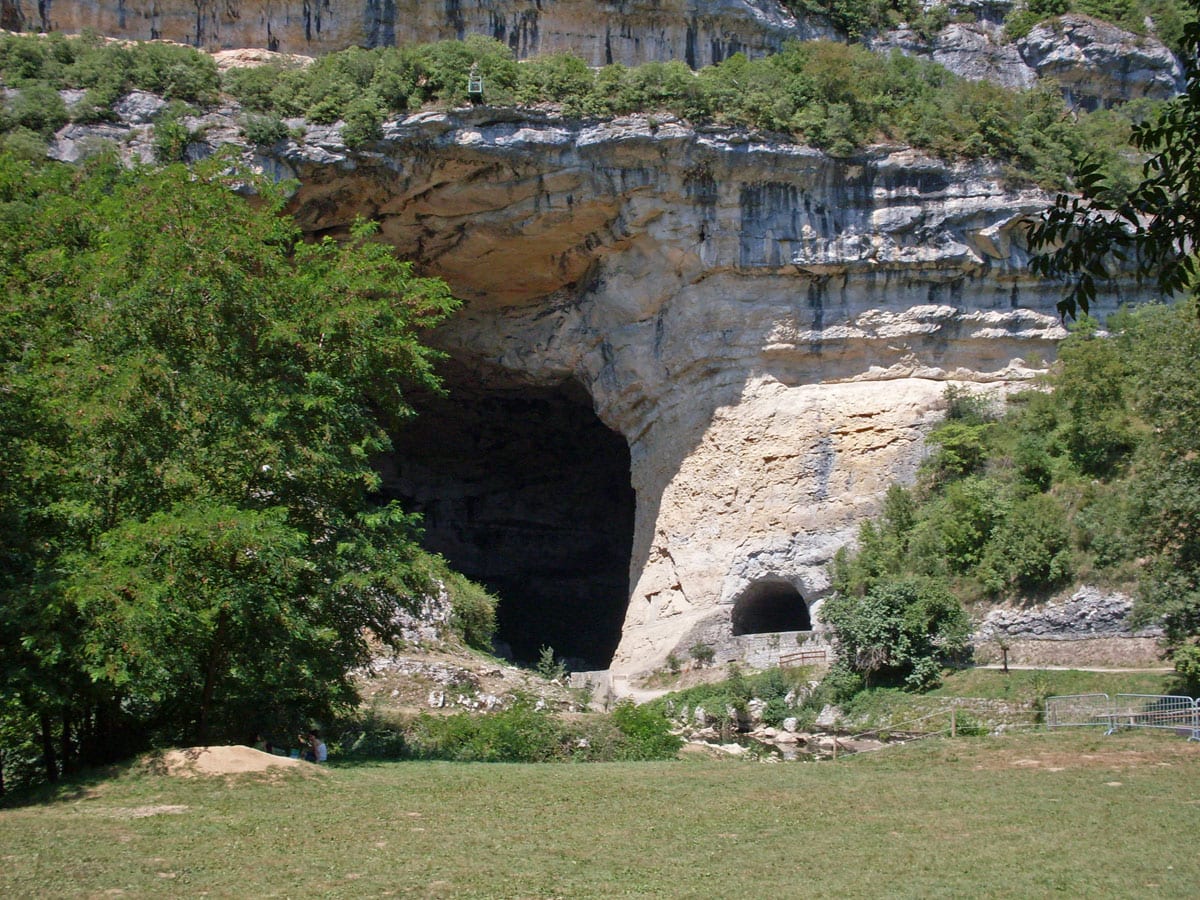
- Grotte de Bédeilhac – Ariège. Enormous cave with prehistoric paintings, mainly depicting animals. Here found also small sculptures. Created in Magdalenian period 15,000 years ago.
- Grottes de Cougnac – Lot. Two caves – one is adorned with beautiful cave formations, another contains cave art from Gravettian (25,000 BP) and Magdalenian (14,000 BP) periods.
- Grottes de Gargas – Hautes-Pyrénées. Famous cave, adorned with prehistoric paintings from Upper Paleolithic period. Paintings mostly are hand stencils, but also drawings of animals. Some drawings might be up to 27,000 years old. Here have been found artifacts from Mousterian to the Middle Ages.
- Grotte de Marsoulas – Haute-Garonne. Small, 50 m long cave. Walls adorned with prehistoric paintings, mainly bison and horses. Mainly made in Magdalenian period.
- Grotte de Niaux and Grotte de Lombrives – Ariège. Niaux cave contains paintings from Magdalenian period some 13,000 years ago. Drawings show almost all fauna of Pyrenees from this period. Also graffiti from Medieval times. Part of 13 km long cave system. Paintings are some 700 m from the entrance – people were coming here on special occasions. Connected to Grotte de Lombrives, forming a 39,000 m long network of passages.
- Grotte des Merveilles – Lot. Interesting, 50 m long cave. It is adorned with speleothems, also gours. Walls of cave are adorned with prehistoric paintings – hand stencils and drawings of animals. Drawings most likely are made some 20,000 years ago.
- Grotte des Trois Frères – Ariège. Cave with interesting prehistoric paintings. Some paintings show half-people – half-animals. One of such drawings shows a horned god. Drawings most likely are made in Magdalenian period.
- Grotte du Mas-d’Azil – Ariège. Enormous cave with remnants of prehistoric settlement. One of entrances is 51 m high and 48 m wide. Here found remnants of extinct Pleistocene mammals. Here lived people of Epipaleolithic age, their culture is named after the cave – Azilian culture (10 000 – 7,5000 BC). In the 3rd century here was a chapel of early Christians.
Urban planning monuments
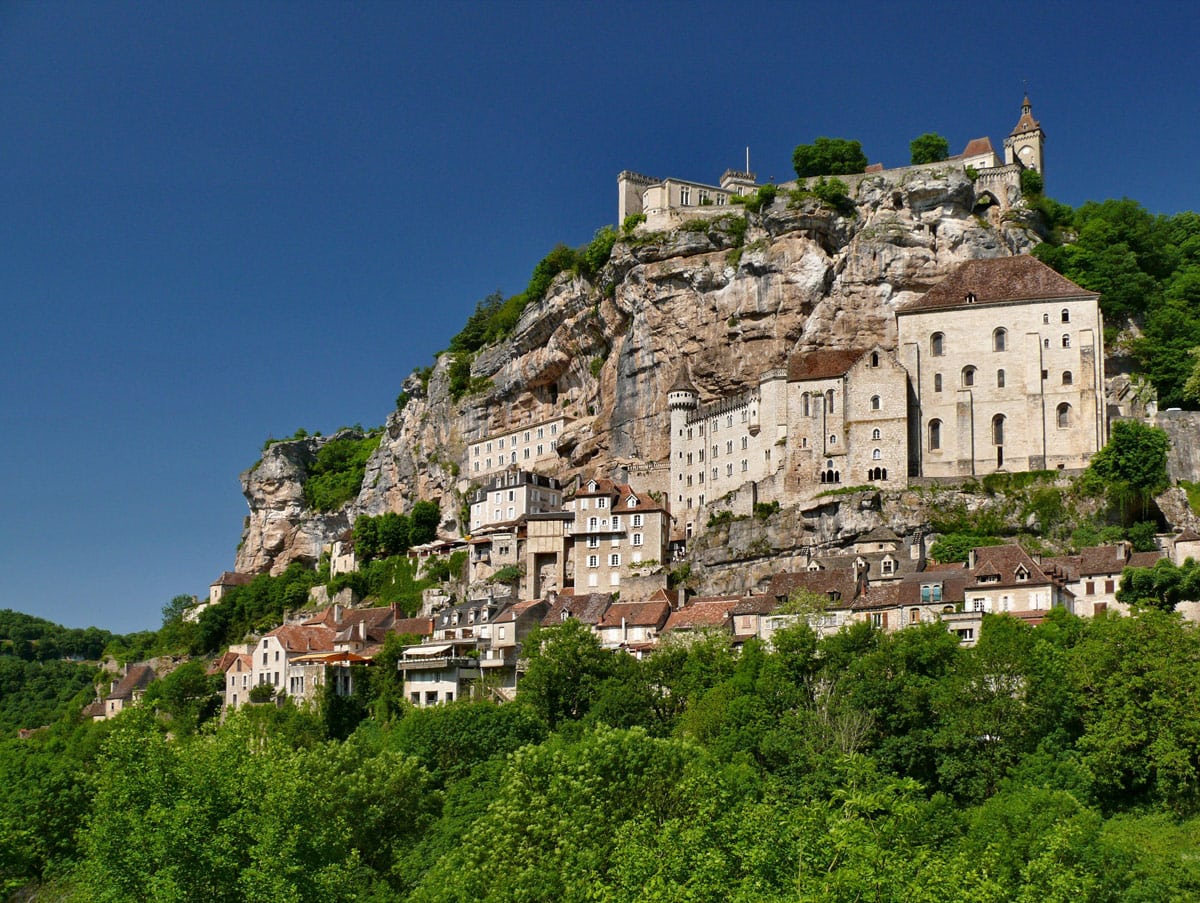
- Albi historical center – Tarn. Well preserved medieval city, which developed as episcopal city around the cathedral.
- Belcastel – Aveyron. Historical village, developed around a castle. Church and bridge built in the 15th century. Castle is renovated.
- Bruniquel – Tarn-et-Garonne. Small fortified village with preserved medieval fortification walls. Two castles.
- Cahors medieval center – Lot. A medieval city, located on a peninsula formed by river Lot. This picturesque city has many interesting medieval buildings and there open fine views on it from the steep banks in the opposite side of the river.
- Carennac – Lot. Medieval village with houses placed in a half ring. Located above the cliff towering above Dordogne. Very interesting monastery, church and castle. The wooden ceiling in the ceremonial hall of the castle is adorned with paintings.
- Castelnau-de-Montmiral – Tarn. Fortified medieval town in beautiful natural setting, on a top of hill.
Conques – Aveyron. Well preserved, picturesque medieval town. Many streets are off-limits to cars. - Figeac historical center – Lot. Well preserved medieval center of pilgrimage town with many churches and other valuable buildings.
- Fourcès – Gers. Medieval bastide – a town, where houses are arranged in a circle. Central plaza has a park and is surrounded by an arcade.
- La Couvertoirade – Aveyron. Well fortified medieval town with impressive walls around it. Fortress built by Knights of Templars in the 12th – 13th centuries.
- Larressingle – Gers. Fortified and visually impressive village – a group of buildings enclosed with a high, 270 m long wall.
- Lautrec – Tarn. Medieval village with many interesting buildings, including a windmill from the 17th century which still is working.
- Lauzerte – Tarn-et-Garonne. Fortified town on the top of hill. Residential buildings from the 13th century, as well as churches and a monastery.
- Loubressac – Lot. Fortified medieval village, located on an rocky outcrop.
- Monestiés – Tarn. Fortified medieval village with houses located in a compact group, forming an outer ring.
- Peyre – Aveyron. A small town, located at the foot of large cliff. Many buildings are partly hewn into the cliffs.
- Puycelci – Tarn. Medieval village on the top of hill, fortified with a wall. Founded in the 10th century. Many houses from the 15th – 16th centuries.
- Rabastens old city – Tarn. Picturesque, well preserved medieval city with fortifications and pilgrimage church.
- Rocamadour – Lot. Beautiful medieval city in dramatic natural setting, perched on cliffs. Part of buildings are hewn in the cliffs. Pilgrimage site. Especially interesting is Le Sanctuaire – the shrine, with several churches one above another.
- Saint-Cirq-Lapopie – Lot. Medieval town in a dramatic location – on a 100 m tall cliff towering above Lot river.
- Saint-Lizier – Ariège. Historical town in picturesque location. Ancient Gallo-Romanic town with many medieval buildings, very picturesque.
- Sarrant – Gers. Fortified medieval village, where the houses are arranged in a circle.
- Sauveterre-de-Rouergue – Aveyron. Interesting medieval town. Basically consists of a large central plaza with arcade and quarters of old buildings around this plaza.
Castles and fortresses
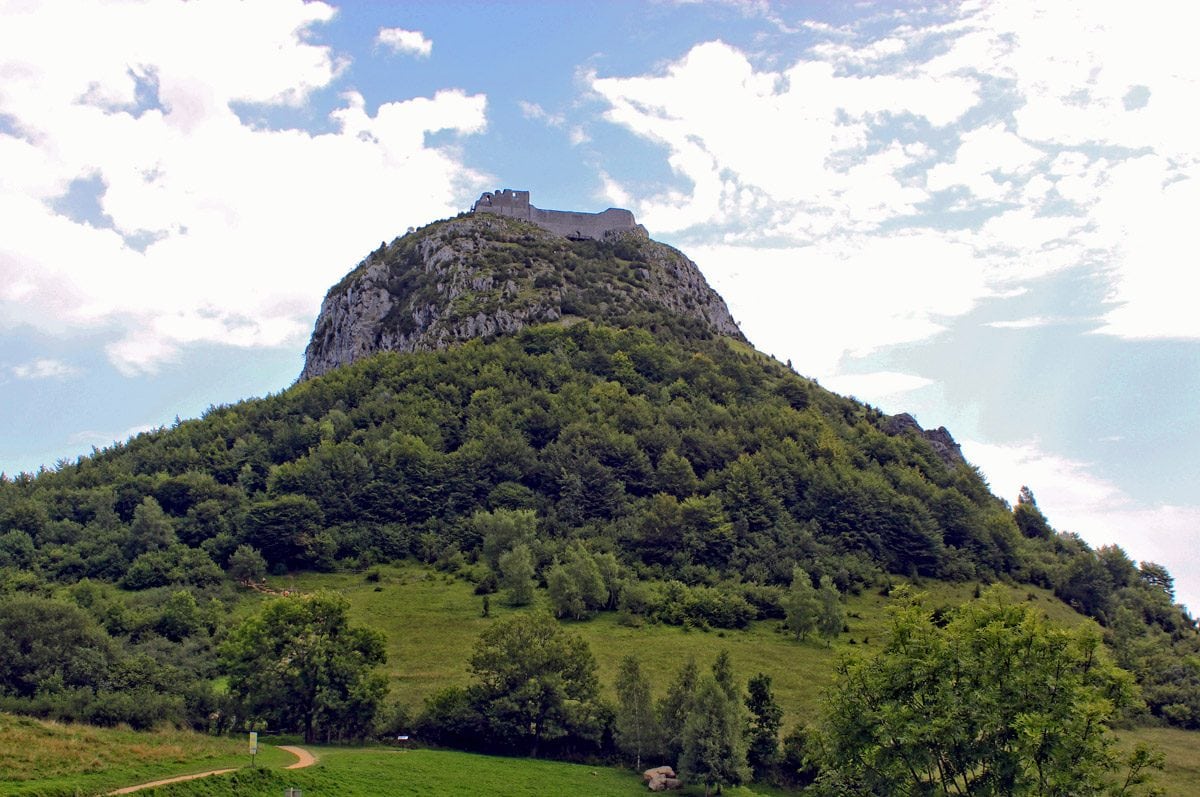
- Château de Foix – Ariège. Large castle in a cliff, rising above the town. Fortification in this site exists since the 7th century, current structure was built later. Now here is located a museum.
- Château fort de Lourdes – Hautes-Pyrénées. Massive castle, towering above the Lourdes town. First fortress built here already in Roman times. Current fort was built in the 11th – 18th century.
- Château de Najac – Aveyron. Impressive castle ruins on the top of hill. Built in 1253 in the site of an older castle. Contains secret corridor and other interesting details.
- Estaing Castle – Aveyron. Enormous castle from the 15th century, towering above the city.
- Montségur fort – Ariège. Fortress on a top of 1,207 m tall mountain peak. This was one of the last Cathar strongholds until 1244. Site of legends about Holy Grail. Fortress was rebuilt in its current forms in the 17th century.
- Palais de la Berbie – Albi. Bishops palace in Albi, one of the best preserved castles in France. Constructed in the end of the 13th century. Now – Toulouse-Lautrec Museum with more than 1000 works.
Churches and monasteries
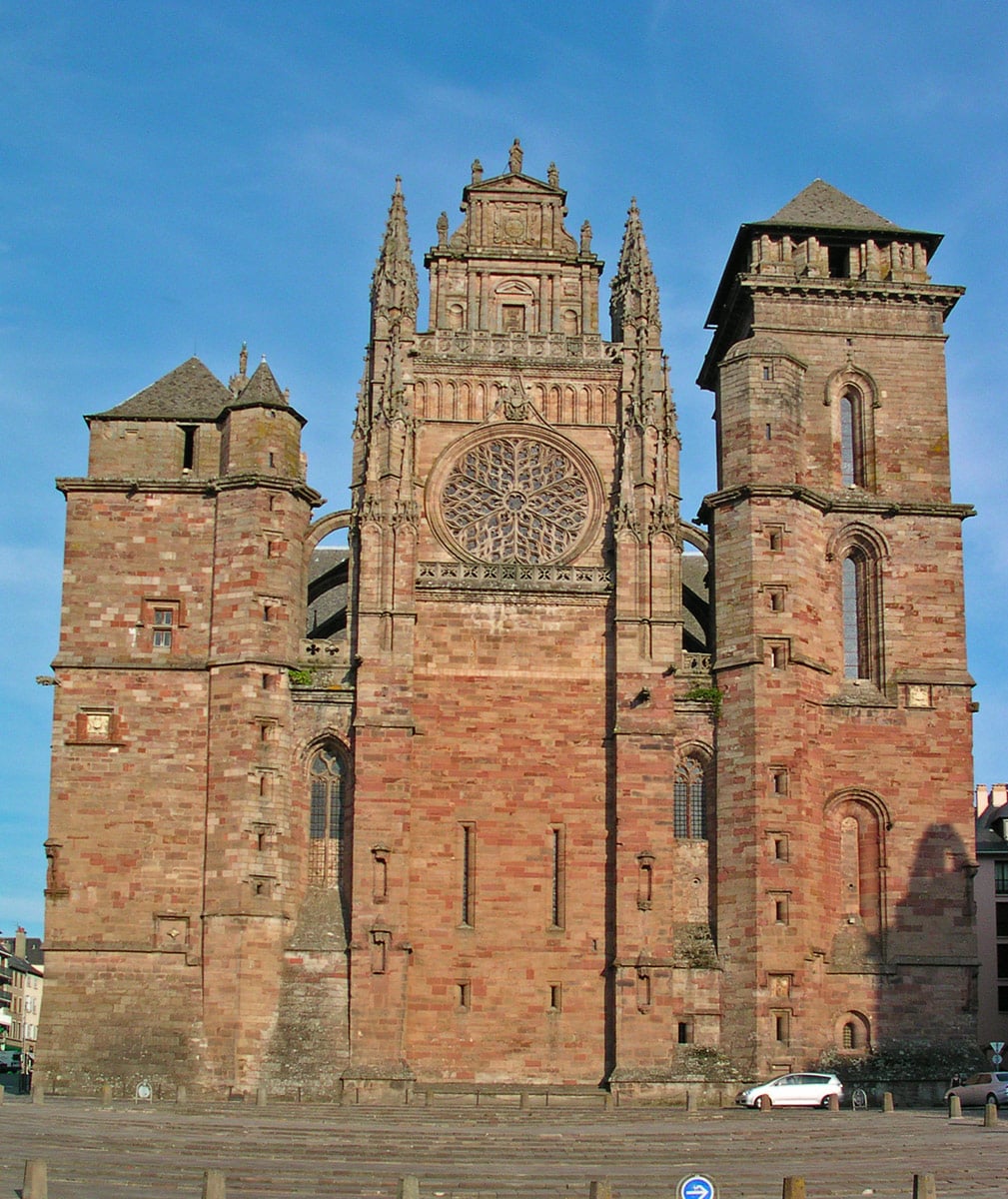
- Albi Cathedral – Tarn. Possibly the largest brick building in the world. Construction of this giant, fortified Gothic church was started in 1287 and for most part completed in 1480. Bell tower is 78 m high, nave is 18 m wide. While the exterior of cathedral is rather grim, interior is sumptuous.
- Auch St. Mary Cathedral – Gers. Late Gothic – Renaissance cathedral, built in 1489 – 1680. Adorned with beautiful Renaissance stained glass windows.
- Basilique de Notre Dame de l’Immaculée Conception, Lourdes – Hautes-Pyrénées. Very ornate Neo-Gothic church, built in 1866 – 1872.
- Basilica of St.Sernin, Toulouse – Haute-Garonne. Giant Romanesque church, built around 1080 – 1120. Very impressive of tower with five tiers.
- Bonneval Abbey – Aveyron. Originally Cistercian abbey, now inhabited by Trappist nuns. Founded in 1147 and soon gained much influence, flourished in the 12th – 13th centuries. Fortified in the 14th – 15th centuries. After longer period of abandonment it was gradually reborn as a monastery since 1875. Here is produced chocolate.
- Cahors Cathedral – Lot. Enormous cathedral, built in Romanesque and Gothic styles. constructed over the 7th century church in the 11th century. Represents a fortified church. The nave is formed by two Byzantine domes, one still has the 14th century frescoes.
- Conques Sainte-Foy abbey church – Aveyron. Large, Romanesque church, built on pilgrimage road to Santiago de Compostela. Adorned with very interesting stone carvings.
- La Romieu church of St.Pierre and tower – Gers. Large Gothic church in this small village. Interesting feature is large, 33 m tall fortified tower at the church. Room in the ground floor is adorned with frescoes.
- Loc-Dieu Abbey – Aveyron. Cistercian abbey, established in 1123 and rebuilt around 1470. Contains intact church from 1159 – 1189 – one of the first Gothic buildings in southern France.
- Moissac Saint-Pierre Abbey – Tarn-et-Garonne. Monastery founded in the middle of the 7th century. Flourished in the 12th and 15th century. Contains one of the most beautiful cloisters in France and great artworks of Romanesque period.
- Persian church in Espalion – Aveyron. Small Romanesque church, named after St. Hilarian who in 730 was beheaded by Saracens. Contains numerous interesting Romanesque artworks including frescoes.
- Rodez Cathedral – Aveyron. Massive, unusual-looking cathedral, built in 1276 – 1531. Built in Gothic style, with rather grim-looking, fortress like facade. 87 m tall bell-tower.
- Saint-Anthonin Cathedral, Pamiers – Ariège. Interesting Romanesque – Gothic church, built in the 12th century, with a single, octagonal tower.
- Saint-Bertrand-de-Comminges cathedral – Haute-Garonne. Enormous church towering in the center of picturesque village. Constructed in Romanesque and Gothic styles, built in the 12th – 14th centuries. Beautiful stained glass.
- Sainte-Marie de Souillac Abbey – Lot. The buildings of abbey were constructed in the 12th century in Byzantine style, with many Romanesque details. Intricate stone carvings.
- Saint-Lizier Cathedral – Ariège. Romanesque cathedral with beautiful cloister. Consecrated in 1117. Interior is adorned with paintings.
Bridges
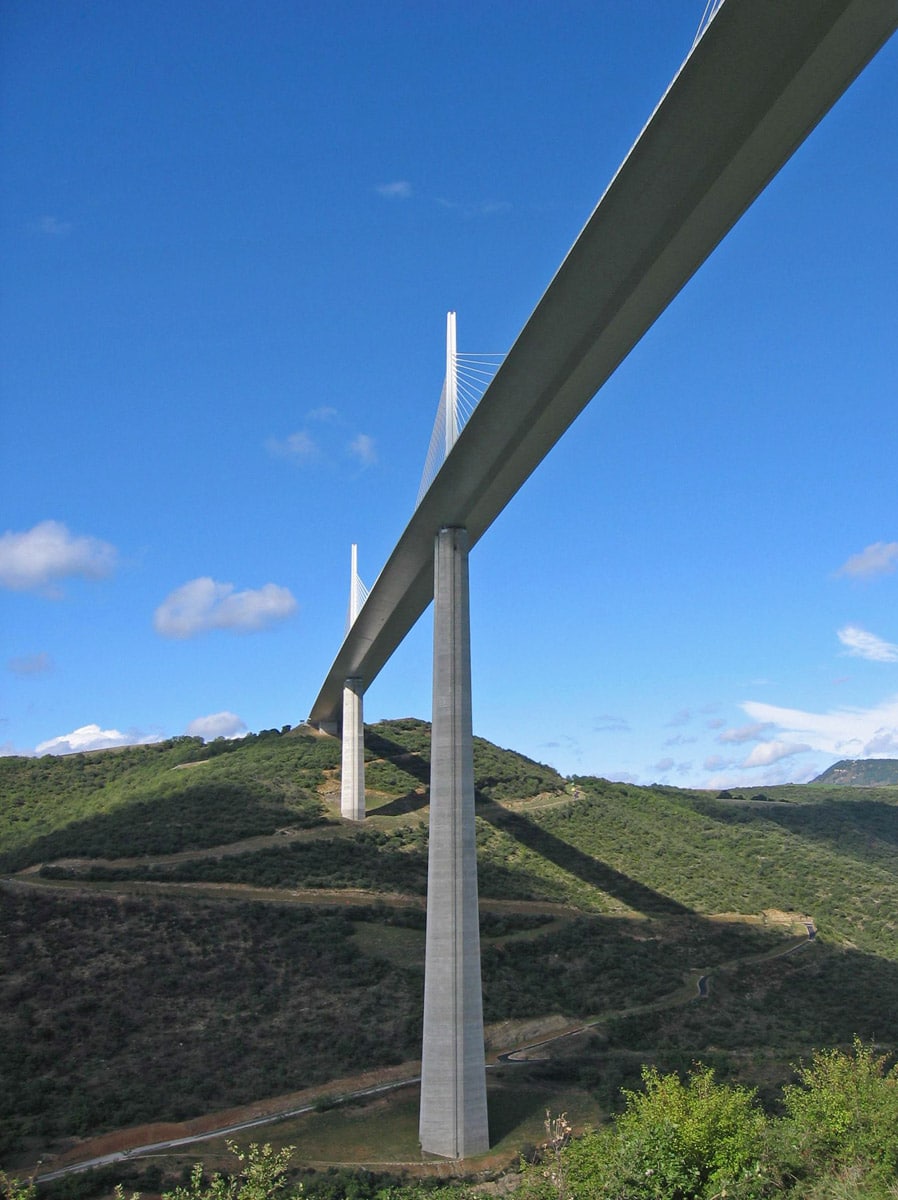
- Espalion Pont-Vieux – Aveyron. Large medieval bridge (1060) with four arches, built from pink sandstone.
- Estaing bridge – Aveyron. Impressive Gothic bridge over Lot river, built in the 16th century.
- Millau Viaduct – Aveyron. Tallest bridge in the world, with up to 343 m tall piers, 2,460 m long. Built in 2004.
- Pont Valentré, Cahors – Lot. Beautiful medieval bridge with six spans. Built in 1308 – 1378 in Gothic style. Fortified with three towers – one stands in the middle of river.
Other man-made landmarks of Midi-Pyrenees
- Brèche de Roland – Hautes-Pyrénées. Site of legends, located on the border with Spain. Legendary natural feature – a gap in cliffs – 40 m wide and with 100 m tall walls in both sides. Located 2,804 m above the sea level. According to legend, it was cut by Roland after the defeat in the Battle at Roncevaux Pass.
- Hôtel d’Assézat – Haute-Garonne. Renaissance palace in Toulouse city, built in the 16th century. Now serves as an art gallery (Fondation Bemberg) and contains very rich art collection.
- Musée des Augustins de Toulouse – Haute-Garonne. Museum of arts, specialized in Medieval art (Romanesque sculpture), but also possessing fine collection of paintings. Much represented art of French painters from the 15th to 20th centuries.
[/su_column]
[su_column size=”1/3″ center=”no” class=””]
Described landmarks of Midi-Pyrénées
Travelers' Map is loading...
If you see this after your page is loaded completely, leafletJS files are missing.
If you see this after your page is loaded completely, leafletJS files are missing.
Midi-Pyrénées is very rich with diverse outstanding natural and man made landmarks. Highlights of this region are:
- The beautiful scenery of Pyrenees. Especially impressive is Cirque de Gavarnie with its incredible waterfalls.
- Urban planning monuments. Here are located numerous spectacular medieval villages, located in dramatic natural setting and adorned with medieval buildings.
- Caves. Region is very rich with very long (longest in France) and very deep caves. Many caves are adorned with prehistoric cave paintings.
- Medieval churches in the small villages. These ancient churches often are very large and impressive and may contain valuable artworks.
Featured: Grande Cascade de Gavarnie (Gavarnie Falls)
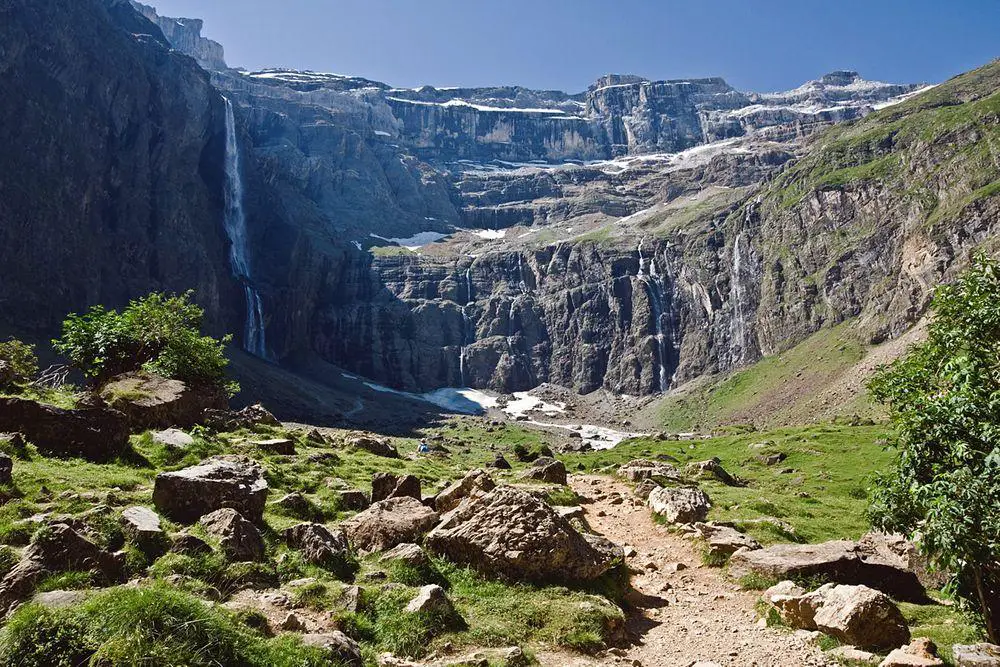
The tallest waterfall in France is Grande Cascade de Gavarnie – Gavarnie Falls. This 422 m tall waterfall forms a magnificent backdrop of Cirque de Gavarnie – the most dramatic landscape in Pyrenees.
Recommended books
Midi-Pyrenees Green Guide 2006
Blue Guide Midi-Pyrenees
This new guide covers the largest region of France, stretching from the Massif Central to the Spanish border.
[/su_column][/su_row]


